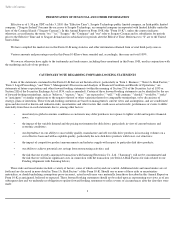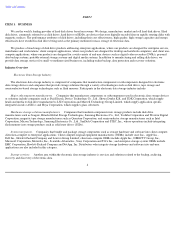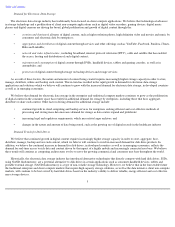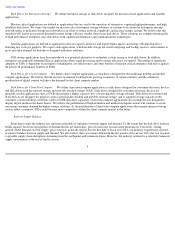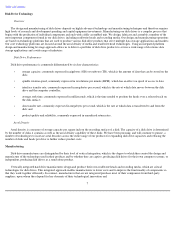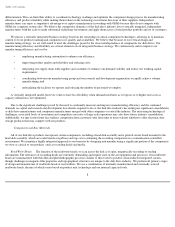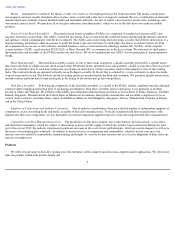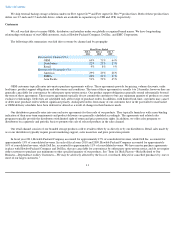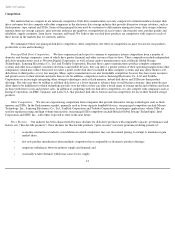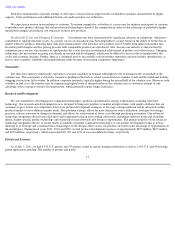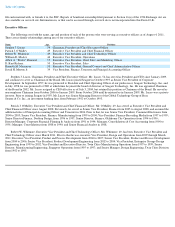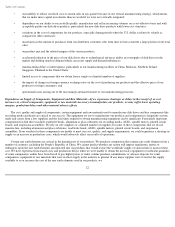Seagate 2010 Annual Report Download - page 15
Download and view the complete annual report
Please find page 15 of the 2010 Seagate annual report below. You can navigate through the pages in the report by either clicking on the pages listed below, or by using the keyword search tool below to find specific information within the annual report.
Table of Contents
Competition
The markets that we compete in are intensely competitive. Disk drive manufacturers not only compete for a limited number of major disk
drive customers but also compete with other companies in the electronic data storage industry that provide alternative storage solutions, such as
flash memory, tape, optical and SSDs. Some of the principal factors used by customers to differentiate among electronic data storage solutions
manufacturers are storage capacity, price per unit and price per gigabyte, storage/retrieval access times, data transfer rates, product quality and
reliability, supply continuity, form factor, warranty and brand. We believe that our disk drive products are competitive with respect to each of
these factors in the markets that we currently address.
We summarize below our principal disk drive competitors, other competitors, the effect of competition on price erosion for our products,
product life cycles and technology.
Principal Disk Drive Competitors. We have experienced and expect to continue to experience intense competition from a number of
domestic and foreign companies, some of which have greater financial and other resources than we have. These competitors include independent
disk drive manufacturers such as Western Digital Corporation, as well as large captive manufacturers such as Hitachi Global Storage
Technologies, Samsung Electronics Co., Ltd. and Toshiba Corporation. Because these captive manufacturers produce complete computer
systems and other non-
compute consumer electronics and mobile devices, they can derive a greater portion of their operating margins from other
components, which may reduce their need to realize a profit on the disk drives included in their computer systems and may allow them to sell
disk drives to third parties at very low margins. Many captive manufacturers are also formidable competitors because they have more resources
and greater access to their internal customers than we do. In addition, competitors such as Samsung Electronics Co., Ltd. and Toshiba
Corporation are increasingly integrating other storage technologies such as flash memory, hybrid disk drives and SSDs into their product
offerings. Not only may they be willing to sell their disk drives at a lower margin to advance their overall business strategy, their portfolio may
allow them to be indifferent to which technology prevails over the other as they can offer a broad range of storage media and solutions and focus
on those with lowest costs and greatest sales. In addition to competing with our disk drive competitors, we also compete with companies such as
Iomega Corporation (an EMC company) and LaCie S.A. that purchase disk drives from us and our competitors for use in their branded storage
products.
Other Competitors. We also are experiencing competition from companies that provide alternative storage technologies such as flash
memory and SSDs. In the flash memory market, primarily used in lower capacity handheld devices, our principal competitors include Micron
Technology, Inc., Samsung Electronics Co., Ltd., SanDisk Corporation and Toshiba Corporation. In enterprise applications, where SSDs are
used for rapid processing and high volume transactions, our principal SSD competitors include Hitachi Global Storage Technologies, Intel
Corporation and STEC Inc., with others expected to enter in the near future.
Price Erosion. Our industry has been characterized by price declines for disk drive products with comparable capacity, performance and
feature sets ("like-for-like products"). Price declines for like-for-like products ("price erosion") are more pronounced during periods of:
•
economic contraction or industry consolidation in which competitors may use discounted pricing to attempt to maintain or gain
market share;
• few new product introductions when multiple competitors have comparable or alternative product offerings;
•
temporary imbalances between industry supply and demand; and
• seasonally weaker demand, which may cause excess supply.
12



